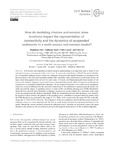Mostrar o rexistro simple do ítem
How Do Modeling Choices and Erosion Zone Locations Impact the Representation of Connectivity and the Dynamics of Suspended Sediments in a Multi-Source Soil Erosion Model?
| dc.contributor.author | Uber, Magdalena | |
| dc.contributor.author | Nord, Guillaume | |
| dc.contributor.author | Legout, Cédric | |
| dc.contributor.author | Cea, Luis | |
| dc.date.accessioned | 2021-04-23T17:52:14Z | |
| dc.date.available | 2021-04-23T17:52:14Z | |
| dc.date.issued | 2021 | |
| dc.identifier.citation | Uber, M., Nord, G., Legout, C., and Cea, L.: How do modeling choices and erosion zone locations impact the representation of connectivity and the dynamics of suspended sediments in a multi-source soil erosion model?, Earth Surf. Dynam., 9, 123–144, https://doi.org/10.5194/esurf-9-123-2021, 2021. | es_ES |
| dc.identifier.uri | http://hdl.handle.net/2183/27804 | |
| dc.description.abstract | [Abstract] Soil erosion and suspended sediment transport understanding is an important issue in terms of soil and water resources management in the critical zone. In mesoscale watersheds (>10 km2) the spatial distribution of potential sediment sources within the catchment associated with rainfall dynamics is considered to be the main factor in the observed suspended sediment flux variability within and between runoff events. Given the high spatial heterogeneity that can exist for such scales of interest, distributed physically based models of soil erosion and sediment transport are powerful tools to distinguish the specific effect of structural and functional connectivity on suspended sediment flux dynamics. As the spatial discretization of a model and its parameterization can crucially influence how the structural connectivity of the catchment is represented in the model, this study analyzed the impact of modeling choices in terms of the contributing drainage area (CDA) threshold to define the river network and of Manning's roughness parameter (n) on the sediment flux variability at the outlet of two geomorphologically distinct watersheds. While the modeled liquid and solid discharges were found to be sensitive to these choices, the patterns of the modeled source contributions remained relatively similar when the CDA threshold was restricted to the range of 15 to 50 ha, with n restricted to the range 0.4–0.8 on the hillslopes and to 0.025–0.075 in the river. The comparison of the two catchments showed that the actual location of sediment sources was more important than the choices made during discretization and parameterization of the model. Among the various structural connectivity indicators used to describe the geological sources, the mean distance to the stream was the most relevant proxy for the temporal characteristics of the modeled sedigraphs. | es_ES |
| dc.description.sponsorship | Francia. Agence Nationale de la Recherche; ANR-11-EQPX-0011 | es_ES |
| dc.description.sponsorship | This research has been supported by the Draix Bléone and OHMCV long-term observatories, funded by the National Institute of Science of the Universe, for access to datasets and the OZCAR research infrastructure (grant no. ANR-11-EQPX-0011). | |
| dc.language.iso | eng | es_ES |
| dc.publisher | Copernicus GmbH | es_ES |
| dc.relation.uri | https://doi.org/10.5194/esurf-9-123-2021 | es_ES |
| dc.rights | Atribución 4.0 Internacional | es_ES |
| dc.rights.uri | http://creativecommons.org/licenses/by/4.0/ | * |
| dc.subject | Soil erosion | es_ES |
| dc.subject | Suspended sediment transport | es_ES |
| dc.subject | Soil resources management | es_ES |
| dc.subject | Water resources management | es_ES |
| dc.subject | Mesoscale watersheds | es_ES |
| dc.title | How Do Modeling Choices and Erosion Zone Locations Impact the Representation of Connectivity and the Dynamics of Suspended Sediments in a Multi-Source Soil Erosion Model? | es_ES |
| dc.type | info:eu-repo/semantics/article | es_ES |
| dc.rights.access | info:eu-repo/semantics/openAccess | es_ES |
| UDC.journalTitle | Earth Surface Dynamics | es_ES |
| UDC.volume | 9 | es_ES |
| UDC.issue | 1 | es_ES |
| UDC.startPage | 123 | es_ES |
| UDC.endPage | 144 | es_ES |
| dc.identifier.doi | 10.5194/esurf-9-123-2021 |






